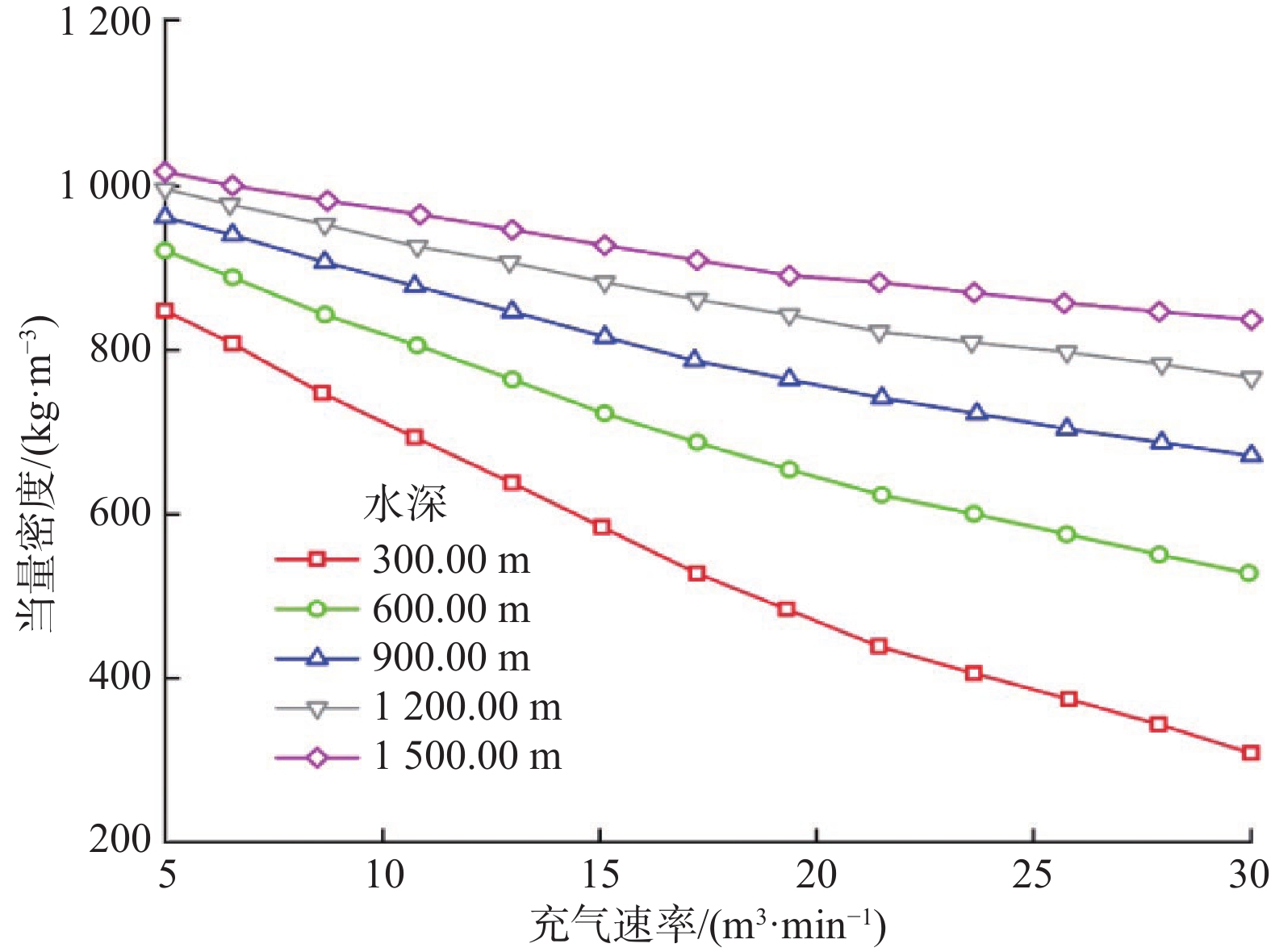Research on Gas-Charging Water Depths and Gas-Charging Rates of Dual-Gradient Drilling with Gas-Charging in Risers
-
摘要: 为确定隔水管充气双梯度钻井充气水深和充气速率,根据气液两相流漂移流理论,考虑气体流动过程中其体积受隔水管环空压力变化的影响,建立了隔水管环空压力计算微元模型,推导出了隔水管充气双梯度钻井充气速率计算模型,并利用现场试验数据验证了模型计算结果的准确性。以南海某深水井为例,利用所建模型分析了施工参数对隔水管充气双梯度钻井充气水深、泥线处环空压力和充气速率的影响。结果显示:进行隔水管充气双梯度钻井时,在0~300.00 m水深段充气对井底压力的调节效果最明显,反应最迅速;在300.00~1 100.00 m水深段,充气只起到辅助调节井底压力的作用;在水深超过1 100.00 m处充气实现双梯度钻井所需的充气速率非常大;井口回压较小时,通过充气调节海底泥线处隔水管环空压力的效率高。研究结果表明,进行隔水管充气双梯度钻井时,应根据水深选择充气点,合理配置充气管路。Abstract: To determine the gas-charging water depths and gas-charging rates of dual-gradient drilling with gas- charging in risers, a differential element model was built for calculating the annular pressure of risers. The model was built according to the drift flow theory of gas-liquid two-phase flow, considering the influence of annular pressure variations of risers on the gas volume during gas flow. Then the model for calculating gas-charging rates was derived for dual-gradient drilling with gas-charging in risers, and field tests were used to verify the results of model. Taking a deep-water well in the South China Sea as an example, the effects of operating parameters on the gas-charging water depths, annular pressure at the mudlines, and gas-charging rates were analyzed by the model proposed for dual-gradient drilling with gas-charging in risers. The results showed that in dual-gradient drilling with gas-charging in risers, the regulation effects of bottom-hole pressure by gas charging are most significant in a water depth within 300 m, with the fastest response. In a water depth range of 300.00–1 100.00 m, gas charging only played an auxiliary role in bottom-hole pressure regulation. When the water depth exceeded 1 100.00 m, a high gas-charging rate was required for dual-gradient drilling by gas charging. When the wellhead back pressure was small, gas charging was highly efficient in regulating annular pressure of risers at the seabed mudlines. The research indicated that in the dual-gradient drilling with gas-charging in risers, gas-charging points could be selected according to water depth, and gas-charging pipelines should be properly deployed.
-
Keywords:
- riser /
- dual-gradient drilling /
- gas-charging rate /
- annulus pressure /
- wellhead back pressure
-
随着我国海洋油气资源开发步伐的加快,深水油气和浅层天然气水合物开发面临的产层易漏、表层疏松和安全密度窗口窄等难题愈发凸显,给井身结构设计、水下钻进、井控等带来了诸多难题,严重制约了海洋油气资源的勘探开发[1]。双梯度钻井技术能够较好地解决上述问题。事实上,国外已实现双梯度钻井的工业化应用:Conoco公司研发的SMD双梯度钻井系统,于2001年在墨西哥湾绿峡136个区块进行了测试,如今已正式投入使用;挪威AGR公司在2005年研发的钻井液回收系统,已经在黑海某油田投入使用,并已取得较好的经济收益。我国双梯度钻井方面的研究和应用尚处于起步阶段,关键技术还未取得突破。为了实现我国海洋油气资源安全自主有效开发,需要掌握双梯度钻井的核心技术。明确环空气液两相流流动规律是研制隔水管充气双梯度钻井设备的关键。目前,已有大量计算气液两相流管内和环空动静态流变参数的模型:Poettman模型可用于管内气液两相流相关参数的计算,不足之处是忽略了气体摩擦力和滑脱造成的影响[2];Woods计算模型适用于环空流型为纯气泡流的计算,在气液比比较低的情况下,其计算结果比较准确,但随着气液比增大,环空中的气体将出现不同的流态,并非单一流态[3];HK模型将流态分为气泡流、段塞流、过渡流和环雾流,井深较浅时,该模型的计算结果与实际偏差较小,但用于深海钻井时,计算存在一定误差,且实际上环空中主要是气泡流和段塞流[4-10]。针对隔水管充气双梯度钻井,国内学者已进行了如下研究:杨小刚[11]建立了气液两相流计算模型,推导出双梯度钻井充气速率计算方程,并进行了井控模拟计算;苗典远[12]通过建立气液固多相流流动方程,计算了充气量,分析了影响充气量的因素;殷志明[13]分析了各种双梯度钻井系统的工作原理,建立了双梯度钻井井筒水力学计算模型;王江帅等人[14]基于井筒流体流动与传热理论,建立了变压力梯度下钻井环空温度和压力预测模型。以上模型都是通过对比压力计算充气速率,需要反复试算,计算过程繁琐,有时还会出现计算结果不收敛的问题,应用不方便,并且大多只是利用模型进行了数值模拟,未通过试验验证。
隔水管充气双梯度钻井通过充气管路向隔水管底部充入气体,降低隔水管环空流体密度,实现井底压力调节[15]。笔者基于这一基本原理,建立了隔水管环空压力计算微元模型,推导出了隔水管充气双梯度钻井充气速率计算模型。利用该模型预测了充气速率,并将预测结果与现场实测数据进行对比,验证了模型的可行性。在此基础上,以南海某深水井为例,分析了施工参数对隔水管充气双梯度钻井充气水深、泥线处环空压力和充气速率的影响,发现隔水管充气双梯度钻井存在3个充气水深段,调压效果受井口回压影响较大,并提出根据充气水深合理配置充气管路,从而更好地实现压力调控。
1. 数学模型的建立
隔水管充气双梯度钻井原理如图1(a)所示。钻井液由钻杆顶部注入,到达钻头后流入环空,而后沿环空上返至井口,经三相分离器后返流至钻井液池。在此过程中,空气压缩机泵出高压气体,经充气管路到达隔水管底部后进入隔水管环空,与环空中的钻井液混合形成含气的钻井液。随着充气速率增大,含气钻井液的密度降低,这样隔水管环空和井眼环空的压力梯度就不同了。当泥线处隔水管环空压力与该深度海水静液柱压力相等时,表明此时含气钻井液的密度已经与海水相同或相近,即实现了隔水管充气双梯度钻井的目的[16]。
为研究隔水管充气双梯度钻井,需建立相关的数学模型。在保证一定精度的情况下,建立数学模型时进行了以下假设:1)气液处于稳态流状态,气液不相融且液体排量已知;2)整个系统没有其他限流装置引起的压力损失,压降是由气液两相流相互作用引起的;3)流体温度为线性变化,未出现局部温度突然变化;4)液体不可压缩,其性质已知且恒定;5)隔水管处于垂直状态,其结构和尺寸已知;6)隔水管出口压力已知,其通常由节流装置控制。
1.1 隔水管环空压力计算微元模型
分析隔水管充气双梯度钻井环空内压力变化规律是建立充气速率计算模型的前提,因此,首先建立隔水管环空压力计算微元模型。如图1(b)所示,将隔水管环空等分为n个微元井段,每微元井段体积为Vh,其中气体的体积为Vg、液体的体积为V1,每微元井段高度为Δh,隔水管环空截面积为A。气体从隔水管底部注入,上升过程中其体积不断增大。
每微元井段流体的质量为:
m=m1+mg=[(1−vg)ρl+ρg]AΔh (1) 式中:m为流体的质量,kg;m1为流体中液体的质量,kg;mg为流体中气体的质量,kg;vg为单位体积流体内气体占比;ρ1为液体密度,kg/m3;ρg为气体密度,kg/m3;A为隔水管环空截面积,m2;Δh为微元井段的高度,m。
在海平面,流体受到的大气压力为
p0 ,水深h处的液柱压力为ph ,则水深h处的总压力为p0 + ph 。沿隔水管环空从上而下流体的温度变化较大,不能用等温压缩过程来表示,于是根据理想气体状态方程建立水深h处与海平面处气体体积的关系:(p0+ph)v′gTh=p0vgT0 (2) 式中:
v′g 为水深h处单位体积流体内气体占比;Th为水深h处流体的温度,K;T0为海平面大气的温度,K。由式(2)可得:
v′g=p0vgTh(p0+ph)T0 (3) 假设同一层单位体积流体内气体占比相同,则水深h处流体的密度ρh为:
ρh = (1−v′g)ρl = [1−p0vgTh(p0 + ph)T0]ρl (4) 假设水深h+dh处的压力为p0+ph+dp,因为dh很小,可以认为流体的密度还未发生改变,则:
dp=0.01ρhdh (5) 整理得:
(p0 + ph)T0(p0 + ph)T0−p0vgThdp = 0.01ρldh (6) 对式(6)进行积分,即得到整个隔水管内流体的液柱压力:
∫(p0 + ph)T0(p0 + ph)T0−p0vgThdp = ∫0.01ρldh (7) 式(7)即隔水管环空压力计算模型,借助数值计算软件求解该式即可求得隔水管环空内压力。
1.2 漂移流模型的应用
由于式(7)未考虑气液摩阻作用,求解精度有限,故引入漂移流模型进行修正。漂移流模型是工程中应用较好的计算模型之一,针对流体流动产生的摩阻、气液两相的相互作用以及空泡率的计算具有较高的求解精度[17]。
¯α = ¯βC0 + ¯ugj¯J (8) 式中:
¯α 为截面平均空泡率;¯β 为截面平均体积空泡率;C0 为分布系数;¯J 为流体截面平均表观速度,m/s;¯ugj 为平均漂移速度,m/s。在实际两相流中,分布系数
C0 和平均漂移速度¯ugj 并不能直接测得[18],笔者采用Hibiki-Ishii方法计算分布系数C0 :C0 = 1.2−0.2√ρgρl (9) 采用Taitel和Duakler方法计算压降
pθ :dpθ dh=−τlsl + τgsgA + ρlAl + ρgAgAg (10) 式中:
τl 和τg 分别为液体和气体的剪切应力,N/m2;sl 和sg 分别为液体和气体的湿周长,m;Al 和Ag 分别为管子界面液体和气体的面积,m2;g为重力加速度,m/s2。考虑到研究对象是气液两相流的稳态流动,所以将漂移流中气相漂移速度计算公式的应用范围扩大,用其求解气相平均漂移速度,即:
¯vg=(4.8663¯α+0.5607)(ρl−ρggδρ2l)1/144 (11) 式中:
¯vg 为气相平均漂移速度,m/s;δ为液相表面张力,N/m2。同理,液相平均漂移速度为:
¯vl=HQl(1−¯α)V (12) 式中:
¯vl 为液相平均漂移速度,m/s;Ql 为钻井泵排量,m3/s;V 为隔水管环空总体积,m3;H为隔水管总长度,m。气液平均漂移速度比为:
S=¯vg¯vl (13) 式中,S为气液平均漂移速度比。
1.3 充气速率工程算法
由于液体不可压缩,所以未充气时,隔水管环空中流体的当量密度就是液体密度ρ1。
向隔水管环空充气达到稳态后,隔水管环空中流体的当量密度
ρ2 为:ρ2 = M′1 + MgV (14) 式中:
ρ2 为充气达到稳态后,隔水管环空流体的当量密度;kg/m3;M′1 和Mg 分别为充气达到稳态后,隔水管环空流体中液体和气体的质量,kg。充气前后隔水管环空流体当量密度的变化
γ 为:γ = ρ1−ρ2 = M1V−M′l + MgV (15) 气体的质量很小,因此可忽略不计,即:
γ = M1−M′lV (16) {V′l = (1−γρ1)VV′g = V−V′l = γρ1V (17) 式中:
γ 为充气前后隔水管环空流体当量密度的变化,kg/m3;V′l 和V′g 分别为充气达到稳态后隔水管环空中液体和气体的体积,m3。充气达到稳态后,根据理想气体体积状态方程,可得到隔水管环空中气体的体积,即:
V′g = ∫i+HinRT106pτdh = ∫H0nRT106pτdh (18) 式中:i为所取井段底部的深度,m;
pτ 为充气达到稳态后,将隔水管环空等分为n个井段,每一井段所受的液柱压力(τ = 1∼n ),MPa。大气压对应水柱高度为10.336 m,则i取10.336 m。隔水管环空总体积
V = (πrG2−πrz2)H ,即:Vg′ = ∫H0nRT106pτdh = γρ1V = γρ1(πrG2−πrz2)H (19) 式中:
rG 为隔水管内径,m;rz 为钻杆外径,m;H为隔水管总深度,m。利用式(7)求出的压力未考虑气液两相相互作用对压降的影响,故在此进行修正,可由
pτ=p−dpθ 表示。结合式(17)和式(19)可得:∫H0nRT106pτdh=∫H0nRT106(p−dpθ)dh=γρ1(πr2G−πr2z)H (20) n=γ(πr2G−πr2z)H∫H0ρ1106(p−dpθ )dh (21) 标准状况下1 mol任何理想气体的体积都是22.4 L,即:
Vgs = 22.4γ(πrG2−πrZ2)H∫H0RT103(p−dpθ )dh (22) 式中:
Vgs 为井段内气体在标准状况下的体积,m3。处于动态平衡时,气液的滑速比为
S ,若钻井液充满液体占用体积的时间为t,则气体充满气体占用体积的时间就是t/S ,结合式(17)得:t=V′1Q1=(1−γρ1)(πr2G−πr2z)Q1 (23) 式中:
Ql 为钻井液排量,m3/s。Qg=VgsSt=22.4γSQ1(ρ1−γ)∫H0ρ1RT103(p−dpθ )dh (24) 式中:
Qg 为气体排量,m3/s。至此,获得了隔水管充气双梯度钻井充气速率计算模型及其全部参数的确定方法。
2. 模型验证
将陆上试验井隔水管充气双梯度钻井试验数据与上述隔水管充气双梯度钻井充气速率计算模型的预测结果进行对比,以验证该模型的可行性。陆上试验井井深700.00 m,利用试验井已有井身结构模拟隔水管,钻杆底部加装充气接头,充气管路沿钻杆外侧至底部连接充气接头,测压短接安装在充气接头下端测量井底压力,如图2所示。
利用陆上试验井进行隔水管充气双梯度钻井试验,主要测试不同泵排量条件下井底压力与气体流量(空气压缩机排量)的关系。采用井下测压短接监测井深270.00 m处的压力,地面传感器记录空气压缩机的压力和排量等数据。从试验结果中选取5个泵排量下的试验数据与模型计算结果进行对比,结果见表1。由表1可知,最小相对误差出现在1-A组,为3.6%,最大相对误差出现在6-E组,为7.3 %,模型计算结果与试验实测结果的相对误差在10%之内,满足工程计算精度要求。产生误差的主要原因是,海洋隔水管充气双梯度钻井的充气管线放置于隔水管外,不占用环空体积,而陆上试验井进行充气双梯度钻井试验时,充气管路放置于环空中,导致环空体积变小。
表 1 陆地井试验数据Table 1. Test data of onshore wells组号 泵排量/(L·s–1) 气体注入压力/MPa 立管压力/MPa 井深270.00 m处压力/MPa 气体流量/(m3·min–1) 相对误差,% 实测 计算 1-A 25.0 3.09 4.80 2.74 1.48 1.545 3.6 2-C 25.0 3.05 4.48 2.67 1.83 1.936 5.8 3-F 21.3 3.25 3.12 2.55 2.15 2.269 5.5 5-F 15.4 3.17 1.34 2.47 2.18 2.323 6.5 6-E 13.0 3.12 0.80 2.36 2.14 2.296 7.3 3. 充气调压影响因素
以南海某井为例,将海水密度作为隔水管充气双梯度钻井充气段当量密度的调节目标,采用建立的井底压力与充气速率模型,进行隔水管充气调压影响因素分析。该井隔水管外径513.0 mm、内径489.0 mm,钻杆外径127.0 mm,钻头直径215.9 mm,充气管内径75.0 mm,海水密度1.02 kg/L,充气速率10~50 m3/min,井口回压0.5~3.5 MPa,水深1 500.00 m,钻井液排量20~50 L/s,钻井液密度1.1~1.5 kg/L,温度根据南海海域海水温度梯度计算得到。
3.1 充气水深分析
在隔水管充气进行双梯度钻井时,由于隔水管环空中气体体积直接影响钻井液密度,而井底压力与钻井液密度直接相关,故通过研究隔水管环空中气体体积的变化来分析充气调压的有效水深[19-21]。图3为采用不同密度钻井液实现隔水管充气双梯度钻井时,隔水管环空中气体体积与充气水深的关系。图4为采用不同密度钻井液实现双梯度钻井时(钻井液排量40 L/s)充气速率与充气水深的关系。
从图3可以看出,隔水管环空中气体体积与充气水深的关系可分为3个阶段:1)在0~300.00 m水深段,隔水管环空中气体体积随充气水深增大呈线性减小趋势,气体体积变化率较大,随充气水深增深气体体积快速变小。这表明在该水深段充气对井底压力的影响最明显,反应最迅速。2)在300.00~1 100.00 m水深段,气体体积总体处于较低水平并且变化率较小。这表明在该水深段充气对隔水管环空中流体当量密度的调节不明显,在井底压力调控中处于辅助调节水深段,反应也不够迅速。水深超过1 100.00 m,气体高度压缩,气体体积变化率很小。超过该水深想要实现双梯度钻井,不仅需要很高的充气速率,并且需要很高的充气压力。在隔水管进行充气双梯度钻井时,可以根据水深,配置不同数量和尺寸的充气管路,通过各个水深段的相互配合,实现压力调控。
从图4可以看出,随着充气水深增加,充气速率及其变化率均相应增加。这是由于随着充气水深增加,气体体积越来越小,想要实现相同当量密度调节所需要的充气速率就更大。在水深1 100.00 m处存在充气速率增量变化拐点,当水深超过1 100.00 m时,水深对充气速率的影响加剧,实现相同当量密度的调节所需要的充气速率增量骤增,这与图3得到的结论相同。此外,充气速率过高容易在近井口井段形成段塞流,影响钻井液的携岩能力[22]。
3.2 井口回压影响分析
在控压钻井中,调节和控制井口回压是控制井底压力的一种常用方法。此外,提高井口回压可以抑制井筒内气体的膨胀,防止井喷发生。利用上文模型分析水深1 500.00 m、钻井液排量40 L/s、钻井液密度1.10 kg/L条件下,井口施加不同回压对隔水管环空含气率的影响,结果见图5。从图5可以看出,当充气速率一定时,随着井口回压升高,0~300.00 m水深段含气率降低趋势很明显。而该井段是决定调压效果的关键井段,含气率降低必然导致调压效果大幅降低。
利用上文模型分析水深1 500.00 m、钻井液排量40 L/s、钻井液密度1.3 kg/L条件下,井口施加不同回压对泥线处隔水管环空压力的影响,结果见图6。从图6可以看出,井口回压每升高1 MPa,充气速率需要升高20%~40%才能抵消掉其对泥线处环空压力造成的影响。这是因为,井口回压升高会导致隔水管上部环空压力增大,压力会随着液柱压力从上到下累加,引起整个隔水管环空压力升高。这就使得气体在隔水管环空一直处于高度压缩状态,导致需要采用更大的充气速率。这表明,合理且较小的井口回压是保证充气高效调节泥线处环空压力、实现双梯度钻井的前提条件。
3.3 充气速率影响分析
利用上文模型分析钻井液排量40 L/s、钻井液密度1.1 kg/L条件下,充气速率对不同水深处隔水管环空流体当量密度的影响,结果见图7。从图7可以看出:随着充气速率升高,不同水深处隔水管环空流体当量密度不断降低;随着水深增加,充气速率对隔水管环空流体当量密度的影响程度降低。这是因为随着水深增深,隔水管环空中气体体积占比较小的井段增长,如想降低当量密度,就需要更高的充气速率。但充气速率过高会使环空压力进一步升高,进一步压缩气体体积,多重因素联合作用导致充气速率对隔水管环空流体当量密度的影响程度降低。
当隔水管长度为1 500.00 m,采用不同密度钻井液实现双梯度钻井时,利用上文模型分析充气速率与钻井液排量的关系,结果见图8。从图8可以看出:随着钻井液排量增大,实现双梯度钻井所需要的充气速率也更高;随着所用钻井液密度升高,充气速率随钻井液排量增大而升高的幅度减小。在实际钻井作业过程中,可依据钻井液排量和密度选取隔水管充气双梯度钻井所需要的充气速率。
4. 结 论
1)隔水管充气双梯度钻井在0~300.00 m水深段充气,调节井底压力的效果最明显,反应最迅速;在300.00~1 100.00 m水深段充气,只对调节井底压力起辅助作用,反应不够迅速;在水深超过1 100.00 m井段进行隔水管充气双梯度钻井,所需的充气速率将大幅升高。
2)在应用隔水管充气双梯度钻井技术钻井时,可以根据水深配置充气管路和选择充气点位,以实现更好的压力调控效果。
3)较小的井口回压是保证隔水管充气双梯度钻高效调节井底压力、实现双梯度钻井的前提条件,在应用隔水管充气双梯度钻井技术钻井时,应保证管路畅通,同时尽可能降低井口回压。此外,还需要合理调控充气速率,防止充入的气体在隔水管近井口段因压力低体积膨胀形成大段段塞流,进而影响钻井液的携岩能力。
-
表 1 陆地井试验数据
Table 1 Test data of onshore wells
组号 泵排量/(L·s–1) 气体注入压力/MPa 立管压力/MPa 井深270.00 m处压力/MPa 气体流量/(m3·min–1) 相对误差,% 实测 计算 1-A 25.0 3.09 4.80 2.74 1.48 1.545 3.6 2-C 25.0 3.05 4.48 2.67 1.83 1.936 5.8 3-F 21.3 3.25 3.12 2.55 2.15 2.269 5.5 5-F 15.4 3.17 1.34 2.47 2.18 2.323 6.5 6-E 13.0 3.12 0.80 2.36 2.14 2.296 7.3 -
[1] 王江帅,李军,柳贡慧,等. 基于井下分离的深水双梯度钻井参数优化[J]. 石油勘探与开发,2019,46(4):776–781. WANG Jiangshuai, LI Jun, LIU Gonghui, et al. Parameter optimization of deepwater dual gradient drilling based on downhole separation[J]. Petroleum Exploration and Development, 2019, 46(4): 776–781.
[2] 王建云,杨晓波,王鹏,等. 顺北碳酸盐岩裂缝性气藏安全钻井关键技术[J]. 石油钻探技术,2020,48(3):8–15. WANG Jianyun, YANG Xiaobo, WANG Peng, et al. Key technologies for the safe drilling of fractured carbonate gas reservoirs in the Shunbei Oil and Gas Field[J]. Petroleum Drilling Techniques, 2020, 48(3): 8–15.
[3] CHEN Xuyue, YANG Jin, GAO Deli, et al. The maximum-allowable well depth while drilling of extended-reach wells targeting to offshore depleted reservoirs[J]. Energies, 2018, 11(5): 1072. doi: 10.3390/en11051072
[4] GUO Yanli, SUN Baojing, ZHAO Keke, et al. A prediction method of natural gas hydrate formation in deepwater gas well and its application[J]. Petroleum, 2016, 2(3): .296–300. doi: 10.1016/j.petlm.2016.06.004
[5] 天工. 控压钻井技术新进展[J]. 天然气工业,2019,39(2):83. TIAN Gong. New progress in managed pressure drilling technology[J]. Natural gas industry, 2019, 39(2): 83.
[6] CHANG Yuanjiang, CHEN Guomin, WU Xiangfei, et al. Failure probability analysis for emergency disconnect of deepwater drilling riser using Bayesian network[J]. Journal of Loss Prevention in the Process Industries, 2018, 51: 42–53. doi: 10.1016/j.jlp.2017.11.005
[7] 王江帅,李军,柳贡慧,等. 气侵条件下新型双梯度钻井环空出口流量变化规律研究[J]. 石油钻探技术,2020,48(4):43–49. WANG Jiangshuai, LI Jun, LIU Gonghui, et al. Study on the change law of annular outlet flow rate in new-type dual-gradient drilling under gas cut condition[J]. Petroleum Drilling Techniques, 2020, 48(4): 43–49.
[8] XU Yuqiang, GUAN Zhichuan, XU Chuanbin, et al. Numerical method and analysis of ultrasonic detection of gas kick in deepwater risers during offshore drilling[J]. International Journal of Heat and Mass Transfer, 2019, 136: 1311–1326. doi: 10.1016/j.ijheatmasstransfer.2019.03.102
[9] 刘伟,周英操,石希天,等. 塔里木油田库车山前超高压盐水层精细控压钻井技术[J]. 石油钻探技术,2020,48(2):23–28. LIU Wei, ZHOU Yingcao, SHI Xitian, et al. Precise managed pressure drilling technology for ultra-high pressure brine layer in the Kuqa Piedmont of the Tarim Oilfield[J]. Petroleum Drilling Techniques, 2020, 48(2): 23–28.
[10] BARRY A. Subsea rotating device enhances dual gradient drilling[J]. Offshore, 2013, 73(3): 48–50.
[11] 杨小刚. 双梯度钻井井控中的多相流动计算[D]. 青岛: 中国石油大学(华东), 2009. YANG Xiaogang. Calculation of multiphase flow in dual-gradient well control [D]. Qingdao: China University of Petroleum (East China), 2009.
[12] 苗典远. 隔水管气举双梯度钻井注气量计算及其影响因素分析[J]. 石油钻探技术,2013,41(2):23–27. doi: 10.3969/j.issn.1001-0890.2013.02.005 MIAO Dianyuan. Calculation of gas injection volume of riser gas-lift double-gradient drilling and analysis of its influencing factors[J]. Petroleum Drilling Tecniques, 2013, 41(2): 23–27. doi: 10.3969/j.issn.1001-0890.2013.02.005
[13] 殷志明. 新型深水双梯度钻井系统原理、方法及应用研究[D]. 青岛: 中国石油大学(华东), 2007. YIN Zhiming. New dual-gradient deepwater drilling system: principle, method and application [D]. Qindao: China University of Petroleum (East China), 2007.
[14] 王江帅,李军,柳贡慧,等. 变压力梯度下钻井环空压力预测[J]. 石油学报,2020,41(4):497–504. doi: 10.7623/syxb202004012 WANG Jiangshuai, LI Jun, LIU Gonghui, et al. Prediction of drilling annular pressure under variable pressure gradient[J]. Acta Petrolei Sinica, 2020, 41(4): 497–504. doi: 10.7623/syxb202004012
[15] 王果. 基于三级反馈调节的控压钻井回压自动调控方法[J]. 石油钻采工艺,2019,41(4):441–447. WANG Guo. Automatic backpressure control techniques of MPD drilling based on three-layer feedback regulation method[J]. Oil Drilling & Production Technology, 2019, 41(4): 441–447.
[16] TORISA K S, MIWA S. Robust bubble feature extraction in gas-liquid two-phase flow using object detection technique[J]. Journal of Nuclear Science and Technology, 2020, 57(1): 1–14. doi: 10.1080/00223131.2019.1647894
[17] DUAN Liqin, SONG Jinming, LI Xuegang, et al. Glycerol dialkyl glycerol tetraethers signature in sediments of the East China Sea and its implication on marine and continental climate and environment records[J]. Ecological Indicators, 2019, 103: 509–519. doi: 10.1016/j.ecolind.2019.04.040
[18] WANG Jiangshuai, LI Jun, LIU Gonghui, et al. Development and application of wellbore heat transfer model considering variable mass flow[J]. Underground Space, 2020, 6(3): 316–328.
[19] 周云龙,陈旭,郭新田,等. 三面加热窄矩形通道内气液两相流流型研究[J]. 原子能科学技术,2018,52(7):1262–1267. doi: 10.7538/yzk.2017.youxian.0689 ZHOU Yunlong, CHEN Xu, GUO Xintian, et al. Research on the flow pattern of gas-liquid two-phase flow in a narrow rectangular channel heated on three sides[J]. Atomic Energy Science and Technology, 2018, 52(7): 1262–1267. doi: 10.7538/yzk.2017.youxian.0689
[20] WANG Xuerui, SUN Baojiang, LUO Pingya, et al. Transient temperature and pressure calculation model of a wellbore for dual gradient drilling[J]. Journal of Hydrodynamics, 2018, 30(4): 701–714. doi: 10.1007/s42241-018-0063-0
[21] SUN Wanchun, LIU Yanchu, HE Kui, et al. The phase distribution of gas-liquid two-phase flow in microimpacting T-junctions with different branch channel diameters[J]. The Chemical Engineering Journal, 2018, 333: 34–42. doi: 10.1016/j.cej.2017.09.136
[22] SUMI T, KUROTAKI T, OHSAWA K, et al. Preliminary study on compressible gas-liquid two-phase flow computation for ultra-high-pressure fuel injection process[J]. Transactions of the JSME (in Japanese), 2019, 85(872): 18–00332.
-
期刊类型引用(32)
1. 段世明,宋先知,姚学喆,祝兆鹏,许争鸣. 压力与规则双约束下的溢流智能预警模型. 石油机械. 2025(01): 1-9 .  百度学术
百度学术
2. 范翔宇,蒙承,张千贵,马天寿,李柱正,王旭东,张惊喆,赵鹏斐,邓健,周桂全. 超深地层井壁失稳理论与控制技术研究进展. 天然气工业. 2024(01): 159-176 .  百度学术
百度学术
3. 朱焕刚,燕修良,畅元江,许磊,王超. 随机波浪及平台运动下控压钻井隔水管端部轴向位置预测方法. 力学与实践. 2024(03): 472-481 .  百度学术
百度学术
4. 刘伟,韩霄松,付加胜,唐纯静,郭庆丰,赵庆. C/S架构的新型控压钻井计算模拟与控制软件. 吉林大学学报(信息科学版). 2024(04): 637-644 .  百度学术
百度学术
5. 韦龙贵,张伟国,罗黎敏,杜威,雷磊,王哲,罗源. 数字化井控技术研究现状及发展趋势. 钻采工艺. 2024(04): 86-93 .  百度学术
百度学术
6. 李晓刚,苗典远,刘宝生,徐鲲,陈树恩,张俊奇,张杰. 海洋精细控压钻井技术现状及应用. 钻采工艺. 2024(04): 105-112 .  百度学术
百度学术
7. 阎荣辉,韦海防,许朝阳,杨赟,陈志勇,王军闯,王培峰,彭炽,熊知非. 控压钻井实时计算及控制决策方法研究. 钻采工艺. 2024(04): 113-119 .  百度学术
百度学术
8. 周英操,郭庆丰,蔡骁,王正旭. 精细控压钻井技术及装备研究进展. 钻采工艺. 2024(04): 94-104 .  百度学术
百度学术
9. 米晓军,刘东伟,杨保健,闫成双,关皓纶. 精细控压钻井技术研究及应用现状浅析. 中国石油和化工标准与质量. 2024(19): 186-189 .  百度学术
百度学术
10. 刘伟,付加胜,郭庆丰,赵庆. 智能控压钻井关键技术研究进展与展望. 石油钻探技术. 2024(05): 42-50 .  本站查看
本站查看
11. 畅元江,许磊,王保琳,张晏铭,刘俊言. 深水控压钻井隔水管系统连接作业窗口分析. 中国海上油气. 2024(06): 92-99 .  百度学术
百度学术
12. 张桂林,张晓林. “液量稳定”控压钻井技术研究与现场应用. 石油钻探技术. 2024(06): 16-22 .  本站查看
本站查看
13. 汪海阁,黄洪春,纪国栋,陈畅畅,吕泽昊,陈伟峰,毕文欣,刘力. 中国石油深井、超深井和水平井钻完井技术进展与挑战. 中国石油勘探. 2023(03): 1-11 .  百度学术
百度学术
14. 费中明,刘鑫,张晔,张小建,蒋世伟,沈磊,杨祖富. 准噶尔盆地南缘超深井天X井尾管精细控压固井技术. 钻井液与完井液. 2023(03): 391-396 .  百度学术
百度学术
15. 尹士轩,徐宝昌,孟卓然,陈贻祺. 控压钻井的控制理论研究与装备研发进展. 化工自动化及仪表. 2023(05): 622-631 .  百度学术
百度学术
16. 谯世均,赵江源,岳龙,王青华. 集成橇装控压钻井系统在C909井的应用. 钻采工艺. 2023(05): 162-166 .  百度学术
百度学术
17. 丁志敏,郑权宝,邵长春,袁野,夏天果,孙志. 钻具和环空双密度钻井液碳酸盐岩储层钻井工艺. 石油钻采工艺. 2023(06): 668-674 .  百度学术
百度学术
18. 伍贤柱,胡旭光,韩烈祥,罗园,许期聪,庞平,李黔. 井控技术研究进展与展望. 天然气工业. 2022(02): 133-142 .  百度学术
百度学术
19. 霍宏博,李金蔓,张磊,岳明,刘海龙. 海洋窄压力窗口钻井技术. 石油工业技术监督. 2021(04): 40-44 .  百度学术
百度学术
20. 罗鸣,冯永存,桂云,邓金根,韩城. 高温高压钻井关键技术发展现状及展望. 石油科学通报. 2021(02): 228-244 .  百度学术
百度学术
21. 孙金声,刘伟. 我国石油工程技术与装备走向高端的发展战略思考与建议. 石油科技论坛. 2021(03): 43-55 .  百度学术
百度学术
22. 王华平,王富渝,罗良仪,张春林. 高密度油基钻井液敏感地层变密度控压钻井技术. 钻采工艺. 2021(06): 45-48 .  百度学术
百度学术
23. 吴波,黄志安,王委. D1-1HF井溢漏同存安全钻完井新技术应用. 钻采工艺. 2021(06): 132-135 .  百度学术
百度学术
24. 谭鹏,何思龙,李明印,陈雪峰,张景田,马喜伟. 库车坳陷超深层复杂气田钻完井技术. 石油钻采工艺. 2021(05): 580-585 .  百度学术
百度学术
25. 李根生,宋先知,田守嶒. 智能钻井技术研究现状及发展趋势. 石油钻探技术. 2020(01): 1-8 .  本站查看
本站查看
26. 刘伟,周英操,石希天,王瑛,雷万能,李牧. 塔里木油田库车山前超高压盐水层精细控压钻井技术. 石油钻探技术. 2020(02): 23-28 .  本站查看
本站查看
27. 薛倩冰,张金昌. 智能化自动化钻探技术与装备发展概述. 探矿工程(岩土钻掘工程). 2020(04): 9-14 .  百度学术
百度学术
28. 王建云,杨晓波,王鹏,范红康. 顺北碳酸盐岩裂缝性气藏安全钻井关键技术. 石油钻探技术. 2020(03): 8-15 .  本站查看
本站查看
29. 梁丰. 精细控压钻井井底压力自动控制技术初探. 中国石油和化工标准与质量. 2020(08): 242-243 .  百度学术
百度学术
30. 南旭. 控压钻井技术在四川威远页岩气井的应用研究. 中国石油和化工标准与质量. 2020(10): 224-225 .  百度学术
百度学术
31. 刘伟,李牧,何思龙,雷万能,房超,唐雷. 库车山前超高压盐水层控压固井实践与认识. 钻采工艺. 2020(05): 31-33+94+6-7 .  百度学术
百度学术
32. 王佑林. 国外精确控压钻井技术进展研究. 江汉石油科技. 2019(03): 49-52 .  百度学术
百度学术
其他类型引用(7)




 下载:
下载:















































































